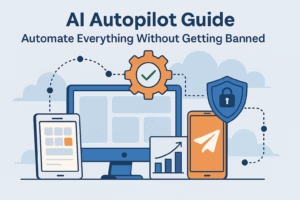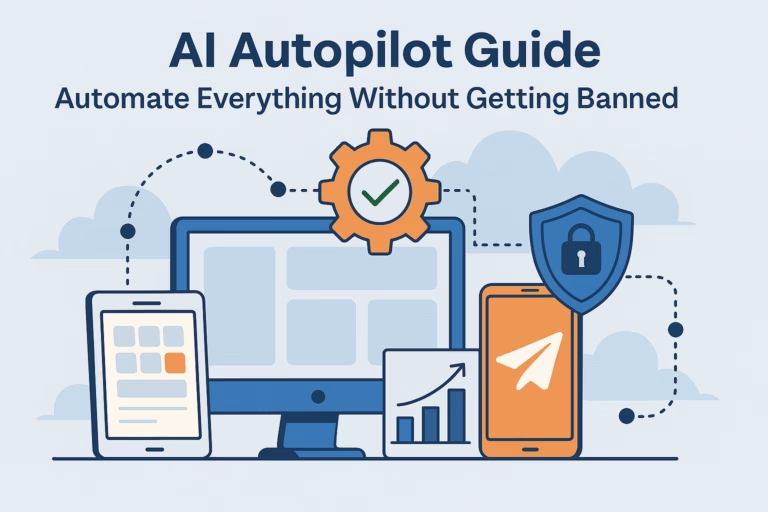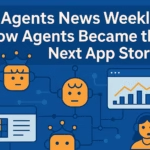- Speed doesn’t equal safety. Automation must move at believable human pace.
- Keep one rhythm. The One Dashboard Rule protects consistency and reduces detection.
- Mix formats and timing. Variety tells algorithms you’re real.
- Automate honestly. Only delegate tasks you’d normally do yourself.
- Long-term growth beats instant spikes. Consistent, safe automation always wins.
Every founder loves the idea of automation until their account gets locked. You spend weeks building systems, scheduling posts, and setting up flows, then suddenly wake up to that cold message: “Your account has been suspended for suspicious activity.”It’s not bad luck. It’s sloppy automation.
Most people rush into AI tools thinking speed is the goal. But the fastest systems are also the riskiest. Platforms like Instagram, TikTok, and LinkedIn track behavioral fingerprints patterns too perfect to be human. Once their filters detect them, you’re gone.
The truth is, AI autopilot can safely handle everything posting, DMs, emails, even analytics if they behave naturally. That means variable pacing, organic rhythms, and a unified dashboard instead of a dozen competing logins.
In this guide, you’ll learn exactly how to automate everything without getting banned.
I’ll show you where creators mess up, what safe automation looks like in 2025, and how one platform quietly solved the risk problem without throttling creativity. (Yes, I’m talking about Blaze Autopilot).

Why People Get Banned
Every automation ban starts the same way: a good system pushed too hard. The algorithm isn’t your enemy it’s just allergic to repetition. When it detects patterns that don’t match normal human behavior, it assumes you’re cheating.
These are the four big mistakes most people make when setting up their first AI autopilot:
-
Posting too fast. Flooding your feed looks robotic even if the content is good.
-
Copying captions. Identical text across posts trips duplicate content flags.
-
Jumping IPs. Logging in from different countries through unsecured tools confuses platforms.
-
Mass messaging. Sending hundreds of DMs without cooldowns screams “bot.”
Here’s a clean breakdown of what these triggers look like and how to avoid them:
| Trigger | What It Looks Like | How to Avoid It |
|---|---|---|
| Posting Too Fast | 10+ posts per hour across platforms | Limit to scheduled windows and vary timing |
| Duplicate Captions | Identical wording on multiple posts | Rotate templates and include natural variation |
| IP Mismatch | Different logins from far locations | Use one consistent connection or proxy |
| Spammy DMs | Auto-sending identical messages | Throttle DMs and personalize replies |
Every platform has invisible thresholds. You don’t need to memorize them just move like a human. If you wouldn’t post 12 times in an hour manually, don’t let your software do it either.
The best AI autopilots, like Blaze, already bake this pacing in. They imitate real-time behavior instead of brute force execution.
That’s how automation becomes invisible.
The Safe Automation Framework
Safe automation is not about slowing down. It’s about blending in. The smartest systems follow a rhythm that feels alive, not mechanical. I call it the three-layer safety net, and it protects your accounts while keeping automation profitable.
1. The Moderation Layer
This layer controls pacing. It makes sure posts, DMs, and comments follow natural intervals. You don’t post five times in a row and vanish for a week. You show steady, believable activity that algorithms read as genuine.
2. The Behavior Layer
Automation should mimic curiosity, not spam. Each interaction looks a little different captions vary, timings shift, responses feel unique. The point is to build a pattern that’s predictable to you, but random enough for machines.
3. The Integration Layer
This is what most people skip. If you’re using ten different tools that log in separately, you’re leaving footprints everywhere. A single system that manages posting, scheduling, and data keeps your actions unified. That consistency is what keeps your automation undetectable.
Here’s a quick guide that outlines what “safe” actually means across different platforms:
| Platform | Max Daily Posts | Safe DM Range | Best Practice |
|---|---|---|---|
| 5 to 8 | 15 to 25 personalized | Mix stories, reels, and carousels | |
| TikTok | 3 to 5 | N/A | Use varied sounds and captions |
| 1 to 2 | 5 to 10 outreach messages | Engage before you pitch |
This isn’t just about avoiding flags. It’s about building trust with algorithms. Platforms reward consistent, authentic activity. Once your system behaves that way, your reach grows naturally, without pushing limits or tripping filters.
How an AI Autopilot Works Safely
A real autopilot doesn’t just post for you. It learns from you. It watches patterns what times your audience reacts, which formats bring engagement, which days convert best and then adjusts its rhythm quietly in the background.
Here’s what separates safe systems from the ones that get banned:
-
Variable timing. Every post is offset slightly so no two actions happen in the same minute.
-
Content diversity. The system rotates between reels, stories, and carousels so you look human, not repetitive.
-
Predictive analytics. Instead of posting by schedule alone, it reacts to engagement signals from past data.
-
Cooldown management. It never stacks too many interactions too close together.
These principles create a pattern that feels unpredictable to machines but totally natural to followers.
When automation works safely, it doesn’t look like a robot. It looks like consistency the kind that shows up every day without strain, drama, or fear of a ban.
The One Dashboard Rule
Most automation failures start with tool chaos. One app for captions. Another for analytics. A third for emails. Every new login increases your digital fingerprint, and platforms notice those mismatched behaviors.
The solution is what I call the One Dashboard Rule. One login. One IP. One rhythm. Every action comes from a single system, which gives you control and invisibility at the same time.
Think of it like driving in traffic. The reckless drivers weaving between lanes get noticed first. The steady ones glide past unnoticed. Automation works the same way. When every post, reply, and message flows through one consistent hub, it looks smooth and human to the algorithm.
Here’s how that difference plays out:
| Setup Type | Risk Level | Result |
|---|---|---|
| Multiple Tools | High | Inconsistent behavior, logouts, and API errors |
| Unified Dashboard | Low | Consistent posting and minimal detection |
You can still experiment with formats or content types, but the moment you scatter your operations across too many apps, you double your chances of detection. Simplicity is not just efficient. It is safe.
The Ethical Edge
Automation gets a bad name because people try to use it to fake engagement. They automate likes, comments, and DMs hoping to look bigger than they are. That approach always collapses.
The ethical way to use AI autopilots is to automate what you already do not what you wouldn’t do. If you normally post daily, automation simply makes it effortless. If you usually respond to leads, automation just keeps your timing consistent.
There’s a quiet honesty to good automation. It amplifies effort instead of replacing it. When your system mirrors your real rhythm, your growth looks natural, not forced.
Safety isn’t only technical. It’s behavioral. If your automation reflects integrity, the algorithm will reward it, and your audience will trust it. The future of AI isn’t to trick platforms but to partner with them.
A well-run autopilot doesn’t hide your humanity. It highlights it by removing the noise.
Winding Up
Automation used to be about shortcuts. Today, it’s about sustainability. The entrepreneurs who win aren’t the ones posting the most; they’re the ones posting the smartest. They’ve built systems that stay invisible, consistent, and safe while the rest burn out chasing growth.
If there’s one thing this guide should prove, it’s that AI autopilots aren’t dangerous when used with discipline. They’re extensions of focus. Tools don’t get people banned impatience does. The algorithm isn’t watching to punish you. It’s watching for predictability.
When you give your automation rhythm, variety, and consistency, you stop being suspicious and start being dependable. Your business becomes a quiet engine that runs itself while you move on to higher decisions. That’s real leverage.
The future of growth belongs to those who let go of noise, simplify their systems, and trust automation to do what it does best work silently, accurately, and at scale.


